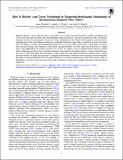Files in this item
How is helicity (and twist) partitioned in magnetohydrodynamic simulations of reconnecting magnetic flux tubes?
Item metadata
| dc.contributor.author | Threlfall, James | |
| dc.contributor.author | Wright, Andrew N. | |
| dc.contributor.author | Hood, Alan W. | |
| dc.date.accessioned | 2020-07-29T15:30:01Z | |
| dc.date.available | 2020-07-29T15:30:01Z | |
| dc.date.issued | 2020-07-20 | |
| dc.identifier | 269326600 | |
| dc.identifier | bcead640-84a4-4394-85d9-8a496b48f254 | |
| dc.identifier | 85089004173 | |
| dc.identifier | 000552319300001 | |
| dc.identifier.citation | Threlfall , J , Wright , A N & Hood , A W 2020 , ' How is helicity (and twist) partitioned in magnetohydrodynamic simulations of reconnecting magnetic flux tubes? ' , Astrophysical Journal , vol. 898 , no. 1 , 1 . https://doi.org/10.3847/1538-4357/ab9c2a | en |
| dc.identifier.issn | 0004-637X | |
| dc.identifier.other | BibCode: 2020ApJ...898....1T | |
| dc.identifier.other | ORCID: /0000-0003-2620-2068/work/78204846 | |
| dc.identifier.other | ORCID: /0000-0002-9877-1457/work/78204900 | |
| dc.identifier.uri | https://hdl.handle.net/10023/20366 | |
| dc.description | Funding: STFC through the Consolidated grant, ST/N000609/1, to the University of St Andrews. | en |
| dc.description.abstract | Magnetic helicity conservation provides a convenient way to analyze specific properties (namely, the linkage and twist) of reconnecting flux tubes and yield additional insight into the pre- and post-reconnection states of magnetic structures in the solar atmosphere. A previous study considered two flux tubes with footpoints anchored in two parallel planes. They showed that reconnection would add self-helicity equivalent to a half turn of twist to each flux tube. We address a related and fundamental question here: if two flux tubes anchored in a single plane reconnect, what are the resulting twists imparted to each of the reconnected tubes? Are they equal and do they have a simple exact value independent of footpoint location? To do this, we employ a new (computationally efficient) method which subdivides each flux tube into distinct elements and calculates the mutual helicity of many elemental pairs, the sum of which determines the self-helicity of the overall flux tube. Having tested the method using a simple analytical model, we apply the technique to a magnetohydrodynamic simulation where initially untwisted magnetic flux tubes are sheared and allowed to reconnect (based on a previous reconnection model). We recover values of self-helicity and twist in the final end state of the simulations which show excellent agreement with theoretical predictions. | |
| dc.format.extent | 9 | |
| dc.format.extent | 1065593 | |
| dc.language.iso | eng | |
| dc.relation.ispartof | Astrophysical Journal | en |
| dc.subject | Magnetic fields | en |
| dc.subject | Solar magnetic reconnection | en |
| dc.subject | Magnetohydrodynamical simulations | en |
| dc.subject | Magnetohydrodynamics | en |
| dc.subject | QB Astronomy | en |
| dc.subject | QC Physics | en |
| dc.subject | Space and Planetary Science | en |
| dc.subject | Astronomy and Astrophysics | en |
| dc.subject | T-NDAS | en |
| dc.subject.lcc | QB | en |
| dc.subject.lcc | QC | en |
| dc.title | How is helicity (and twist) partitioned in magnetohydrodynamic simulations of reconnecting magnetic flux tubes? | en |
| dc.type | Journal article | en |
| dc.contributor.sponsor | Science & Technology Facilities Council | en |
| dc.contributor.institution | University of St Andrews. Applied Mathematics | en |
| dc.identifier.doi | 10.3847/1538-4357/ab9c2a | |
| dc.description.status | Peer reviewed | en |
| dc.identifier.url | http://adsabs.harvard.edu/abs/2020ApJ...898....1T | en |
| dc.identifier.grantnumber | ST/N000609/1 | en |
This item appears in the following Collection(s)
Items in the St Andrews Research Repository are protected by copyright, with all rights reserved, unless otherwise indicated.

